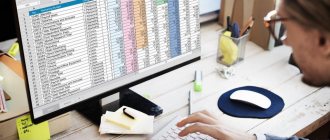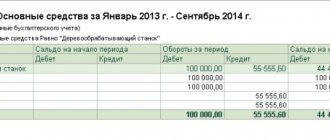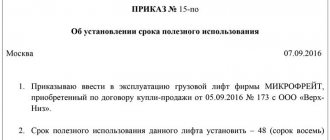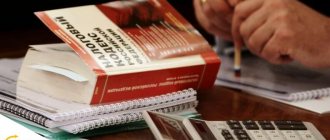Why is account 01 needed?
Accounting account 01 “Fixed assets” was created to record information about the company’s fixed assets.
Here their value and movement are recorded: purchase, sale, commissioning, and so on. Account 01 is active. The debit of the account is an increase in the value of fixed assets, for example, the acceptance of new equipment for accounting as fixed assets. The loan involves a decrease in value and disposal of fixed assets, for example, sale.
The procedure for accounting for fixed assets and recording transactions on account 01 is prescribed in PBU 6/01.
Postings to account 01 in accounting
Attention! See the complete chart of accounts for 2019 with explanations and entries here.
Receipt of fixed assets
The receipt of an object can occur in different ways - as a result of a purchase, a contribution to the authorized capital, under a donation agreement, etc.
When purchasing an operating system, all costs for its acquisition and preparation for use are collected on account 08, after which the entire amount is transferred to account 01, where accounting is performed. The receipt of fixed assets is accounted for using the following transactions:
| Excerpt from the document | ||
| Debit | Credit | |
| 08 | 60 | The purchase of an asset has been completed (the amount is indicated excluding VAT) |
| 19 | 60 | Registered for VAT on the purchased OS |
| 08 | 60, 76 | Work to prepare the object for use, transportation, etc. is taken into account (the amount is indicated excluding VAT) |
| 19 | 60, 76 | VAT on preparation for use is taken into account |
| 01 | 08 | The OS object is registered |
| 68 | 19 | VAT credited |
OS construction
The object can be obtained as a result of capital construction. Moreover, its initial price includes payment for the contractor’s services and the cost of materials for construction.
| Debit | Credit | |
| 08 | 60, 76 | The price of contract work is shown in the accounting |
| 08 | 10 | Raw materials and supplies given for work on the facility are shown in the accounting |
| 08 | 60, 76, 23, 25, 26 | Other costs for building the OS are shown in accounting |
| 19 | 60, 76, 23, 25, 26 | Input VAT on construction work has been taken into account |
| 01 | 08 | The completed OS object has been accepted for operation |
| 68 | 19 | VAT credited |
What is the main tool
The fixed asset of an enterprise is property that has been used for a long time in production and management activities. But do not confuse fixed assets with other company property - materials and inventory. To recognize property as a fixed asset, it must have the following characteristics:
- has a physical form, that is, it can be seen, touched, measured;
- used in the company’s activities - production or management;
- period of use - at least 12 months;
- brings economic benefits to the company;
- is owned and is not for resale.
For example, a woodworking machine worth 1 million rubles will be the main tool if you use it, for example, to cut out boxes. But if you bought a machine to resell it, then this is not an operating system, but a product that is listed on account 41.
Important! The fixed asset can be purchased on lease. But you will reflect it on account 01 only if, under the leasing agreement, the equipment is listed on the balance sheet of the lessee. Typically, the leased property remains on the lessor’s balance sheet, so it is not reflected in the lessee’s account 01. Rented property is not taken into account in account 01.
What is contained in the statement of account 01
Organizations resort to the balance sheet for account 01 in accounting when it is necessary to compile a list of assets that are used in production and making a profit for a long time.
Objects are subject to certain requirements. These are the main assets that:
- Purchased for cash;
- Mounted, built by the organization for production or economic needs;
- Used for more than 12 months;
- They bring profit;
- Will not be sold anytime soon;
- They cost at least 40,000 rubles.
From the turnover information, you can see all the property owned by the organization: office and production buildings, vehicles, machines, equipment that is used in production and economic activities.
Property is reflected in the statement at its original cost or acquisition cost. Installation, adjustment, and commissioning work is also included in the price. The residual value is calculated as the difference between the amount of debit 01 and credit 02 of account for each type of property. The balance of SALT account 01 must be debit.
Separately, information is generated on the turnover subaccounts of account 01. Those fixed assets that are subject to write-off (movement, sale) are moved to debit 01.09. For equipment for which there are temporarily no documents confirming ownership, a subaccount 01.08 is provided.
The report displays commissioning by debit, write-off or other disposal (for example, sale, disposal) of fixed assets by credit. A sample balance sheet for account 01 looks like this:
| Fixed asset item/storage location | Balance at the beginning of the period Debit Credit | Period transactions Debit Credit | balance at the end of period Debit Credit | |||
| Total | ||||||
Note! In accounting (AC), the minimum cost of fixed assets differs from tax accounting (TA). Here the minimum cost is 100,000 rubles.
What sub-accounts are opened for account 01
Account 01, if required, can be detailed. The following subaccounts are opened for accounting:
- production OS for core activities;
- other production operating systems;
- working and productive livestock;
- perennial plantings;
- land plots;
- inventory and so on.
A separate sub-account is also opened to account for the disposal of fixed assets.
Keep records of exports and imports in the Kontur.Accounting web service. Simple accounting, payroll and reporting in one service
How analytical accounting is carried out on account 01
Analytics on account 01 is carried out for each individual property: building, site, line or machine. When accounting on the balance sheet, an inventory card is drawn up for each object. It states:
- name of property;
- model;
- price;
- inventory number;
- serial number;
- quality characteristics.
The inventory card is maintained according to the OS-6 form, approved by Resolution of the State Statistics Committee of Russia dated January 21, 2003 No. 7.
Analytical accounting is also carried out by location, materially responsible persons, OS groups and terms of use.
Fixed assets card sample form
First, we need to consider what the law refers to as the concept of fixed assets.
These are material assets that belong to the company by right of ownership, contribute to production, commercial activities, and management of the organization, being useful to the company for more than one year.
Data entered into the card
All equipment, vehicles, furniture, tools and other equipment that contribute to successful profit-making activities can be considered valuables.
Accounting measures are provided for all materials and documentation at any organization. These are necessary measures to keep things in order and be aware of the state of the company's property fund.
An accounting card for fixed assets is a document whose form is unified by the state, designed to reflect all the information and “history” of the organization’s values and materials.
This may include information about:
- taking ownership of the company;
- internal movement across departments and divisions;
- reconstruction;
- making improvements to the facility;
- the renovation work to which it was subjected;
- writing off the funds.
Entries are made on the basis of drawn up acts or other documents. It can be compiled both for a single instance and for a group of objects. In this case, the card exists in the singular. If the company has a small amount of property, an inventory book can serve as an alternative to a card.
Rules for filling out the card of fixed assets
Its form is divided into several sections, which have their own characteristics:
- The first part should contain information about a tool object that has already been in use and is not newly created. The only thing that can be indicated here is the date of creation of the material and the details of the act according to which it would be accepted as fixed assets.
- The second section is intended to display data on the initial cost of the object, as well as the useful life, when determining which the classifier of fixed assets is used.
- The third section indicates the data when recalculating - this is the date when it was made, the coefficient and the new cost.
- The fourth section is for information that relates to the movement of a fixed asset.
- The fifth part should contain all the changes that occurred to the object - its modernization, reconstruction, modification, and so on.
- The sixth section describes the costs of repairs;
- The last block contains a description of the object, its characteristics, as well as all the items that are part of it, its accessories.
Below is a standard form and a sample fixed asset card, a version of which can be downloaded for free.
Basic operations with account 01
In the work of an accountant, account 01 is used quite often. In the table we have collected the main transactions that you may encounter.
| Debit | Credit | The essence of the operation |
| 01 | 08 | OS accepted for accounting |
| 01 | 83 | OS cost increased due to revaluation |
| 83 | 01 | OS cost decreased due to revaluation |
| 01. Disposal of fixed assets | 01 | The initial cost of the disposed asset was written off |
| 02 | 01. Disposal of fixed assets | Depreciation of retiring fixed assets is written off |
| 91 | 01. Disposal of fixed assets | The residual value of the disposed fixed assets is included in other expenses |
We recommend the cloud service Kontur.Accounting. In our service, you can keep records of operating assets within departments, responsible persons, groups, and so on. In addition to accounting and tax accounting, the system has a salary block, reporting via the Internet and other tools for accountants and managers. We give newbies a free trial period of 14 days.
Basic postings for the OS
Example of OS receipt
When receiving fixed assets, account 08 “Investments in non-current assets” is always used.
The Alpha organization purchases an Epson GT-2500 A4 scanner from RUM-Service LLC. The cost of the scanner is 50,000 rubles, including VAT 18% - 7,627 rubles.
OS is accepted into account 01 at its original cost.
Typical entries:
| Dt | CT | Operation description | Sum | Document |
| 08 | 60 | Receipt from supplier | 50000 | Invoice |
| 01 | 08 | The scanner is registered as an OS object | 50000 | Act OS-1 |
Decommissioning of OS - postings with examples
When writing off assets due to unusability, the Act OS-4 form is used (OS-4b - group write-off, OS-4a - write-off of vehicles).
When an object is disposed of (sale, donation or contribution to the authorized capital), an Acceptance and Transfer Certificate OS-1 (OS-1a) is drawn up.
The organization is writing off the fixed asset Searchlight-1 35mm, synchronous due to wear and tear. Write-off is carried out at the residual value of the object.
| Dt | CT | Operation description | Sum | Document |
| 01(disposal) | 01 | The original cost of the spotlight has been written off | 200000 | OS-4 |
| 02 | 01(disposal) | Accumulated depreciation written off | 160000 | OS-4 |
| 91.2 | 01(disposal) | The residual value of the spotlight has been written off | 40000 | OS-4 |
Postings for OS upgrades
Modernization differs from OS repair in that it improves the original characteristics of the object. As a result of modernization, the purpose of the object, terms of use, etc. may change.
Global LLC decided to modernize the machine to improve the accuracy of parts processing. An agreement was concluded with the contractor StroyServis-M, the cost of modernization work is 47,200 rubles, including VAT 7,200 rubles. The cost of the machine at the time of modernization is 500,000 rubles, accrued depreciation is 140,000 rubles.
Postings:
| Dt | CT | Operation description | Sum | Document |
| 08 | 60 | Cost of modernization costs | 40000 | Act |
| 19 | 60 | VAT | 7200 | Invoice |
| 68 | 19 | VAT is accepted for deduction | 7200 | Book of purchases |
| 01 | 08 | Increase in the initial cost of the machine | 40000 | Accounting information |
| 60 | Payment to the contractor for modernization work | 47200 | Payment order |
Preservation of OS
Preservation of an OS object means its removal from service for a certain period. During the conservation period, no depreciation is charged on this object.
Preservation is carried out by transferring the object from subaccount 01 (assets in operation) to subaccount 01 (assets in conservation). To transfer to conservation, a corresponding order is issued.
OS revaluation
Revaluation of OS is not the responsibility of the organization. But if it is used, this operation is performed annually on the last day of the year. The results of the markdown are reflected in account 91 “Other income and expenses”.
| Dt | CT | Operation description | Sum | Document |
| 91.2 | 01 | The amount of depreciation of the fixed assets object is reflected | Accounting information | |
| 02 | 91.1 | Depreciation adjustment reflected as a result of markdown | Accounting information |
The additional valuation is reflected in account 83 “Additional capital”
| Dt | CT | Description of operations | Sum | Document |
| 01 | 83 | The amount of revaluation is reflected | Accounting information | |
| 83 | 02 | Depreciation adjustment reflected as a result of revaluation | Accounting information |






